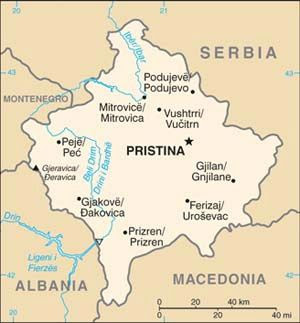Kosovo: What’s So Special About Borders? – Analysis
In the 21st Century – and within the context of bringing both countries into the EU – borders need not be impermeable and enclaves of states within states need not create insurmountable problems.
By Gerard M. Gallucci
The foreign affairs chiefs of the US and EU visited Serbia and Kosovo last week. The main focus was Kosovo and urging both sides to move forward in the renewed dialogue to be overseen by the EU. The pair apparently did not ask that Serbia recognize Kosovo but clearly supported the Pristina position that division of Kosovo is off the agenda and a formula for the north must be found within those parameters. As has been repeatedly stated by Quint and Pristina officials, that means abolishing the “parallel” Serbian institutions in Serb-majority areas of Kosovo and especially in the north. US secretary of state, Hilary Clinton, reportedly told the press after her meeting with Kosovo prime minister, Hashim Thaci, that the US opposes “any discussion of territorial changes or reopening Kosovo’s independent status…the boundaries of an independent, sovereign Kosovo are clear and set.”

The EU and US finesse the recognition issue by asking only for a “progressive normalization” while also making clear that Serbia will not ultimately enter the EU until it has recognized Kosovo. Belgrade was quick to note that neither Clinton – nor EU high representative for foreign affairs, Catherine Ashton – outright demanded that Serbia recognize Kosovo and that this would not, in any case, happen. The government also continued to pledge that its new Kosovo platform will be presented to parliament soon while hinting that no one should expect very much from it. Indeed, as noted previously, it remains difficult to see how Belgrade can emerge with a policy very different from the one pursued by the past government of trying to placate the EU by engaging with Pristina on practical matters while leaving final status for later. Progress can indeed be made on customs, electricity, and telephones – all of which can be dealt with on a status-neutral basis. It remains, however, politically impossible for the Serbian government to outright give up its Kosovo claim or to surrender the north to Pristina. So far the Quint is not offering any other way out for Serbia than to accept these two outcomes.
There are ways to square the circle by adapting some version of an Ahtisaari Plus approach. There are also ways to sidestep the question of sovereignty. Perhaps the US and EU will eventually push Pristina to accept such an approach to keeping the north within Kosovo while allowing it to continue to function as part of Serbia. There are no signs, however, that the Quint is willing to be that imaginative and practical. This leaves only partition as a way to give both sides something while Serbia loses “Kosovo.”
Every once in a while it may be useful to ask again what exactly is so sacrosanct about Kosovo’s borders? The carving out of Kosovo from Serbia was a partition and violated borders. It was not foreseen by the UN Security Council decision (UNSCR 1244) to send peacekeepers there to help oversee substantial autonomy within Serbia. All across Europe, parties and groups have contested and are contesting existing state borders. Neither the UN nor the EU have jumped into these to support any claim to new borders within existing borders. Where groups use violence, state authorities counter with force. More to the point, where such movements push their views through the ballot, the prospect of changing borders through peaceful means has been accepted. Parties pushing for regional statehood contest elections in Belgium, Italy and elsewhere. The UK government has recently granted Scotland the opportunity to have a vote on independence in 2014.
So, why not allow the peoples of Kosovo to vote on their status? (“Peoples” because despite the myth of multi-ethnicity, Kosovo is a collection of ethnic communities.) Why should any community be forced to live in a country they do not choose, especially when some – the Serbs – are being ordered to abandon the country they were born into? Allow all of the municipalities foreseen within the Ahtisaari Plan to vote on whether they are part of Kosovo or Serbia? The northern four will vote for Serbia as may a few of the southern ones. In the 21st Century – and within the context of bringing both countries into the EU – borders need not be impermeable and enclaves of states within states need not create insurmountable problems. This would be a truly European approach to settling the question of Kosovo.
Gerard M. Gallucci is a retired US diplomat and UN peacekeeper. He worked as part of US efforts to resolve the conflicts in Angola, South Africa and Sudan and as Director for Inter-American Affairs at the National Security Council. He served as UN Regional Representative in Mitrovica, Kosovo from July 2005 until October 2008 and as Chief of Staff for the UN mission in East Timor from November 2008 until June 2010.
